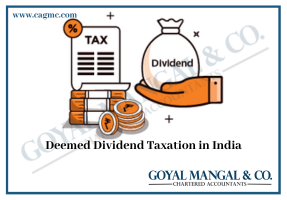
A customs duty is a levy placed on products imported into a country. It is a significant source of money for governments and is used to control the movement of products across borders. Importers must calculate customs duty accurately since it affects the entire cost of importing products and their profitability. The goal of this article is to provide a detailed tutorial on calculating customs duty on imported items in India. It will explain the many forms of customs duty, the elements that influence the computation, and provide practical recommendations and examples to assist readers understand the process better. Readers will have a thorough understanding of how to compute customs accurately at the end of this article. By the end of this article, readers will have a solid understanding of Calculation of Custom duty in India.
|
Table of Content |
What is Custom Duty?
A fee that is levied on merchandise as it is moved across international borders is called a customs duty. Customs duty is an indirect tax imposed on imported goods in India to safeguard the economy, citizens, workforce, environment, and other factors by limiting the movement of commodities into and out of the nation.
The value of the commodities, the place of origin, and the type of goods all affect the customs duty rates in India. A mix of both ad valorem and specific customs duty rates is possible. Depending on the type of goods and the country of origin, India’s customs tax rates can range from 0% to 150%.
The Harmonized System of Nomenclature (HSN) code of the commodities serves as the basis for the Central Board of Indirect Taxes and Customs’ (CBIC) determination of the customs duty rates.
In addition to the applicable customs duty, the Indian government levies 1% customs handling fee on all imports. As a result, when bringing products into India, importers must be aware of the customs tax rates and rules.
Types of Custom Duty
Basic Customs Duty (BCD), Countervailing Duty (CVD), Additional Customs Duty or Special CVD, Protective Duty, Safeguard Duty, Anti-Dumping Duty, and Education Cess are some of the different kinds of customs duties in India.
- Basic Custom Duty (BCD): A charge called the Basic Customs Duty (BCD) is imposed on imported products based on their value. It is a specific kind of customs tax that is applied on merchandise when it is shipped over international borders. BCD is designed to shield domestic businesses from overseas rivalry and to bring in money for the government. The value of the commodities, the place of origin, and the type of goods all affect the customs duty rates in India.
The rates of the customs duties may be ad valorem or a combination of the two. Depending on the type of goods and the country of origin, India’s customs tax rates can range from 0% to 150%. The Central Government establishes the customs duty rates.
- Additional Custom Duty: A customs tax known as a Special CVD or Additional Customs Duty is levied on imported goods to make up for the excise tax paid on equivalent products made in India. A different name for it is Countervailing Duty (CVD). Additional Customs Duty is used to balance imports with periodically imposed domestic taxes such as service tax, VAT, and other domestic taxes. The value of the commodities, the place of origin, and the type of goods all affect the customs duty rates in India.
- Education Cess and Secondary and Higher Education Cess: In India, imports are subject to levies such as the Education Cess and Secondary and Higher Education Cess. The baseline customs duty is supplemented by an additional tax known as the “Education Cess,” which is used to finance primary education programs in India. The education levy is 2% of the total tax due. In addition to the regular customs duty, there is a secondary and higher education cess that goes toward funding secondary and higher education programs in India. The Secondary and Higher Education Cess is one percent of the total tax due. The combined rate of the secondary and higher education cess and the education cess is 3% of the tax due.
- Anti-Dumping Duty: Anti-Dumping Duty is a kind of customs tax that is applied to imports that have prices that are less than the fair market value of comparable products made in the exporting nation. Dumping is the practice of a business selling a product outside of its native market for a far lower price than it would otherwise charge. Anti-Dumping Duty’s main goals are to shield indigenous companies from international competition and stop items from being dumped onto the Indian market.
Factors affecting Custom Duty Calculation
The following factors are considered for determining the customs tax on imported products in India:
- Value of the products: One of the most important variables that can have an impact on the determination of customs tax is the value of the imported products.
- Cost of Products: The cost of the products, insurance premiums, and freight costs incurred in shipping the commodities to India are added to estimate the assessable value of the goods.
- Types of Goods: The types of imported commodities have different customs duty rates in India. Different products are categorized using various Harmonized System (HS) codes, and each HS code has a unique rate for customs duties.
- Country of Origin: Depending on the country of origin of the imported products, India’s customs duty rates also change. Based on the type of products being imported, the HS code, and other considerations, many nations have varied duty rates.
- Transport Method: The method of transport utilized to import the products can have an impact on how much customs tax is charged. For instance, customs duties on air freight may be greater than on maritime freight.
- Packaging of the items: The way the items are packaged can have an impact on how much customs tax is assessed. For instance, commodities with difficult-to-inspect packaging may be subject to higher customs duty rates.
- Exemptions and concessions: The calculation of the customs duty may also be impacted by any exemptions or concessions that apply to the importer. For instance, if certain commodities are imported for a certain use, they may be free from customs duty.
Importers can guarantee a simple and hassle-free customs clearing process by adhering to customs regulations and paying the appropriate amount of customs duty. For importers who want to avoid fines or legal repercussions, it is crucial to comprehend the variables that can impact the calculation of customs duties.
How to calculate Custom Duty in India
Following are the steps for calculating customs duty in India:
- By adding the purchase price, insurance premiums, and freight costs spent during the shipment of the products to India, you can calculate the assessable value of the imported goods.
- Harmonized System (HS) code need to be identified of the imported goods to determine the applicable customs duty rate.
- To establish the appropriate customs duty rate, identify the country of origin of the imported products.
- Determine the basic customs duty rate, which is expressed as a percentage of the products’ assessable value.
- Calculate any additional customs duty rates, such as the Safeguard Duty, Anti-Dumping Duty, Special Additional Duty, and Countervailing Duty, if necessary.
- Determine any importer-specific exemptions or benefits.
- Determine any taxes, such as the Integrated products and Services Tax (IGST) and Compensation Cess, that may be due on the imported products.
- Calculate the entire amount of customs duty that must be paid by adding together all applicable customs duty rates, taxes, and fees
To determine the customs tax due on their imported goods, importers might speak with customs brokers or use internet calculators for customs duties. Importers can guarantee a simple and hassle-free customs clearing process by adhering to customs regulations and paying the appropriate amount of customs duty.
Key points to keep in mind while calculating custom duty
Here are some useful advice and best practices to help you compute customs duty accurately and stay out of trouble:
- Confirm the Authenticity of the Imported items: To prevent any legal issues or confiscation by customs officials, it is crucial to confirm the authenticity and legality of the imported items.
- Speak with Customs Officers if Required: It is advised to speak with customs officials or a qualified service provider if you have any concerns or questions about the procedure for calculating customs duties to ensure compliance with customs laws.
- Keep Accurate Records: To prevent any problems or fines during customs clearance, importers should keep accurate records of the imported products, including the value, country of origin, and classification.
- Investigate Exemptions and Concessions: To lower their import expenses, importers should investigate the exemptions and concessions on customs duty that may be available based on their import category or the nation of origin of the products.
- Maintain Compliance with Customs Regulations: To prevent unpleasant surprises or fines during customs clearance, importers should maintain compliance with the most recent customs regulations and changes in customs duty rates.
Conclusion
In conclusion, it is critical for companies and people involved in importing goods into India to calculate customs duty appropriately. It requires knowledge of the various customs duty kinds, the variables that affect the computation, and the procedures to be followed when calculating customs duty. Importers may make sure they follow the law and stay out of trouble by using the advice and best practices offered in this article.







